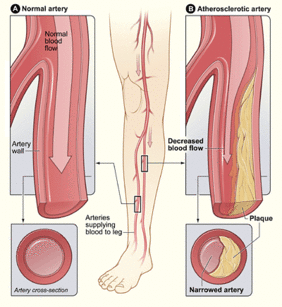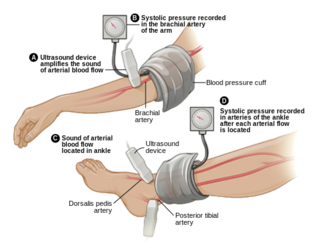Ankle-Brachial Index: Difference between revisions
Chloe Waller (talk | contribs) (Updated resources) |
Chloe Waller (talk | contribs) (Added to procedure) |
||
| Line 8: | Line 8: | ||
The ankle-brachial index (ABI) is a quick, non-invasive technique used to check [[Vascular Pathologies of the Neck|vascular]] status and for [[Peripheral Arterial Disease|peripheral arterial disease]] (PAD)<ref name=":2">McClary KN, Massey P. [https://pubmed.ncbi.nlm.nih.gov/31334946/ Ankle Brachial Index.] 2022 Jan 21. In: StatPearls [Internet]. Treasure Island (FL): StatPearls Publishing; 2022 Jan–</ref><ref name=":0">Aboyans V, Criqui MH, Abraham P, Allison MA, Creager MA, Diehm C, Fowkes FG, Hiatt WR, Jönsson B, Lacroix P, Marin B. [https://www.ahajournals.org/doi/full/10.1161/cir.0b013e318276fbcb Measurement and interpretation of the ankle-brachial index: a scientific statement from the American Heart Association. Circulation]. 2012 Dec 11;126(24):2890-909.</ref>. It was first described by Winsor in 1950<ref>Winsor, T. [https://pubmed.ncbi.nlm.nih.gov/15432446/ Influence of arterial disease on the systolic blood pressure gradients of the extremity]. Am J Med Sci. 1950 Aug;220(2):117-26.</ref>. | The ankle-brachial index (ABI) is a quick, non-invasive technique used to check [[Vascular Pathologies of the Neck|vascular]] status and for [[Peripheral Arterial Disease|peripheral arterial disease]] (PAD)<ref name=":2">McClary KN, Massey P. [https://pubmed.ncbi.nlm.nih.gov/31334946/ Ankle Brachial Index.] 2022 Jan 21. In: StatPearls [Internet]. Treasure Island (FL): StatPearls Publishing; 2022 Jan–</ref><ref name=":0">Aboyans V, Criqui MH, Abraham P, Allison MA, Creager MA, Diehm C, Fowkes FG, Hiatt WR, Jönsson B, Lacroix P, Marin B. [https://www.ahajournals.org/doi/full/10.1161/cir.0b013e318276fbcb Measurement and interpretation of the ankle-brachial index: a scientific statement from the American Heart Association. Circulation]. 2012 Dec 11;126(24):2890-909.</ref>. It was first described by Winsor in 1950<ref>Winsor, T. [https://pubmed.ncbi.nlm.nih.gov/15432446/ Influence of arterial disease on the systolic blood pressure gradients of the extremity]. Am J Med Sci. 1950 Aug;220(2):117-26.</ref>. | ||
The ABI is the ratio between the systolic blood pressure of the lower limb (specifically at the ankle) and the upper limb, to assess for narrowing or blockages in the arteries in the legs<ref name=":2" /><ref name=":3">Mayo Clinic.Ankle Brachial Index. Available from:https://www.mayoclinic.org/tests-procedures/ankle-brachial-index/about/pac-20392934 (Last accessed 12/09/2022)</ref>. | The ABI is the ratio between the systolic blood pressure of the lower limb (specifically at the [[Ankle and Foot|ankle]]) and the upper limb, to assess for narrowing or blockages in the [[arteries]] in the legs<ref name=":2" /><ref name=":3">Mayo Clinic.Ankle Brachial Index. Available from:https://www.mayoclinic.org/tests-procedures/ankle-brachial-index/about/pac-20392934 (Last accessed 12/09/2022)</ref>. | ||
== Indications == | == Indications == | ||
Symptoms of peripheral artery disease: | |||
* Intermittent claudication or cramping pain in the legs.<ref name=":4">[https://journals.lww.com/jwocnonline/fulltext/2012/03001/ankle_brachial_index__quick_reference_guide_for.6.aspx Ankle Brachial Index: Quick Reference Guide for Clinicians.] Journal of Wound, Ostomy and Continence Nursing: March/April 2012 - Volume 39 - Issue 2S - p S21-S29</ref> | * Intermittent claudication or cramping pain in the legs.<ref name=":4">[https://journals.lww.com/jwocnonline/fulltext/2012/03001/ankle_brachial_index__quick_reference_guide_for.6.aspx Ankle Brachial Index: Quick Reference Guide for Clinicians.] Journal of Wound, Ostomy and Continence Nursing: March/April 2012 - Volume 39 - Issue 2S - p S21-S29</ref> | ||
| Line 37: | Line 37: | ||
== Procedures == | == Procedures == | ||
=== Tools === | === Tools<ref name=":4" /> === | ||
* Doppler | |||
* [[Blood Pressure|Blood pressure]] monitor. | |||
* Pressure cuffs | |||
=== Preparation === | === Preparation === | ||
| Line 46: | Line 47: | ||
* Rest for 10-20 minutes prior to the test. | * Rest for 10-20 minutes prior to the test. | ||
* Wear loose, comfortable clothing. | * Wear loose, comfortable clothing. | ||
* Avoid nicotine/ smoking for 2 hours prior to the test. | * Avoid nicotine/ [[Smoking Cessation and Brief Intervention|smoking]] for 2 hours prior to the test. | ||
* Supported, comfortable supine position. | * Supported, comfortable supine position. | ||
=== Technique<ref>Stanford Medicine. Introduction to Measuring the Ankle Brachial Index. Availble from: https://stanfordmedicine25.stanford.edu/the25/ankle-brachial-index.html#:~:text=The%20ABI%20is%20performed%20by,or%2010%2DmHz%20Doppler%20instrument. (Last accessed 13/09/2022)</ref> === | === Technique<ref>Stanford Medicine. Introduction to Measuring the Ankle Brachial Index. Availble from: https://stanfordmedicine25.stanford.edu/the25/ankle-brachial-index.html#:~:text=The%20ABI%20is%20performed%20by,or%2010%2DmHz%20Doppler%20instrument. (Last accessed 13/09/2022)</ref> === | ||
# Place the cuff around the patient's arm, use the | # Place the cuff around the patient's arm, use the doppler and press against the skin at the level of the brachial artery in the arm. Inflate the cuff to about 20 mmHg above the last audible pulse. The Doppler signal should disappear. Then slowly deflate the cuff, approximately 1 mmHg/sec. When the Doppler signal re-appears, the pressure of the cuff is equal to the brachial systolic pressure. Record the brachial systolic pressure. | ||
# Place the cuff around the lower leg and | # Place the cuff around the lower leg and locate two arteries: | ||
## [[Dorsalis Pedis Artery|Dorsalis pedis]], which is a branch from the [[Tibial Nerve|anterior tibial artery]], it is located between the [[Tibialis Anterior|tibialis anterior]] and [[Extensor Hallucis Longus|extensor hallucis longus]] | ##[[Dorsalis Pedis Artery|Dorsalis pedis]], which is a branch from the [[Tibial Nerve|anterior tibial artery]], it is located between the [[Tibialis Anterior|tibialis anterior]] and [[Extensor Hallucis Longus|extensor hallucis longus]] | ||
## Posterior tibial | ## Posterior tibial artery, that is behind the medial malleolus. | ||
# Repeat the same technique as the arm to record the dorsalis pedis and posterior tibial arterty | # Repeat the same technique as the arm to record the dorsalis pedis and posterior tibial arterty: using the doppler to locate the signal, inflating the cuff and then deflating until the signal re-appears. | ||
# The ABI value is calculated by taking the higher pressure of the 2 arteries at the ankle, divided by the brachial arterial systolic pressure. | # The ABI value is calculated by taking the higher pressure of the 2 arteries at the ankle, divided by the brachial arterial systolic pressure. | ||
# Repeat the ankle measurement for the other leg in order to calculate its ABI. | # Repeat the ankle measurement for the other leg in order to calculate its ABI. | ||
Demonstration video: | |||
== Clinical Significance == | == Clinical Significance == | ||
The normal range is between 0.90 and 1.30. below 0.8 means there is a difficulty of blood flow to the foot and lower limb. | The normal range is between 0.90 and 1.30. below 0.8 means there is a difficulty of blood flow to the foot and lower limb. | ||
Revision as of 10:13, 13 September 2022
Original Editor - Khloud Shreif
Top Contributors - Khloud Shreif, Chloe Waller, Vidya Acharya and Lucinda hampton
Introduction[edit | edit source]
The ankle-brachial index (ABI) is a quick, non-invasive technique used to check vascular status and for peripheral arterial disease (PAD)[1][2]. It was first described by Winsor in 1950[3].
The ABI is the ratio between the systolic blood pressure of the lower limb (specifically at the ankle) and the upper limb, to assess for narrowing or blockages in the arteries in the legs[1][4].
Indications[edit | edit source]
Symptoms of peripheral artery disease:
- Intermittent claudication or cramping pain in the legs.[5]
- Wounds on the legs that are slow to heal.[6]
- Leg that feels colder than other parts of the body or is a different shade of color. [6]
Those with risk factors for PAD, such as:[4]
- History of tobacco use
- Restricted blood flow (atherosclerosis) in other parts of your body.
- History of stroke or transient ischemic attack.
- Family history of heart disease.
- Over 70 years of age. [5]
Contraindications[edit | edit source]
- Patients with confirmed or suspected DVT, because of the possibility of breaking of the thrombus.
- Severe leg pain.[5]
Procedures[edit | edit source]
Tools[5][edit | edit source]
- Doppler
- Blood pressure monitor.
- Pressure cuffs
Preparation[edit | edit source]
- Rest for 10-20 minutes prior to the test.
- Wear loose, comfortable clothing.
- Avoid nicotine/ smoking for 2 hours prior to the test.
- Supported, comfortable supine position.
Technique[7][edit | edit source]
- Place the cuff around the patient's arm, use the doppler and press against the skin at the level of the brachial artery in the arm. Inflate the cuff to about 20 mmHg above the last audible pulse. The Doppler signal should disappear. Then slowly deflate the cuff, approximately 1 mmHg/sec. When the Doppler signal re-appears, the pressure of the cuff is equal to the brachial systolic pressure. Record the brachial systolic pressure.
- Place the cuff around the lower leg and locate two arteries:
- Dorsalis pedis, which is a branch from the anterior tibial artery, it is located between the tibialis anterior and extensor hallucis longus
- Posterior tibial artery, that is behind the medial malleolus.
- Repeat the same technique as the arm to record the dorsalis pedis and posterior tibial arterty: using the doppler to locate the signal, inflating the cuff and then deflating until the signal re-appears.
- The ABI value is calculated by taking the higher pressure of the 2 arteries at the ankle, divided by the brachial arterial systolic pressure.
- Repeat the ankle measurement for the other leg in order to calculate its ABI.
Demonstration video:
Clinical Significance[edit | edit source]
The normal range is between 0.90 and 1.30. below 0.8 means there is a difficulty of blood flow to the foot and lower limb.
Below 0.7 means severe peripheral artery disease PAD and the patient may develop ulcer and gangrene[8].
Above the normal level, 1.30 is a sign of calcification of arterial walls that may happen in case of diabetic patients, chronic kidney disease, in this situation you need to measure the ankle pressure at distal digital arteries that is less likely to develop or be calcified
This ABI is not a confirmation for the diagnosis for arteries calcification[9][2].
General Considerations[edit | edit source]
- In normal healthy people, there is a slight decrease in ABI if measured immediately after lower limb exercises due to the decreased ankle systolic pressure because of vasodilation during lower limb exercises, and return to normal within about 3 min after rest.
- There is more decrease in ankle pressure after walking in case of moderate occlusive PAD specifically in the proximal vessels.
- The ABI has a high sensitivity, but these results came from one single study which may be included participants with critical limb ischemia[8] or diabetic patients.
- People with a history of PAD will demonstrate a continuous decrease of ABI over time, about 0.06 over 4.6 years. On the other side, there is a smaller decrease in the general population it's about 0.025 over 5 years[2].
- If the ankle pressure is less than 50 mm Hg it is associated with a higher risk of avascularity and amputation.
Resources[edit | edit source]
References[edit | edit source]
- ↑ 1.0 1.1 McClary KN, Massey P. Ankle Brachial Index. 2022 Jan 21. In: StatPearls [Internet]. Treasure Island (FL): StatPearls Publishing; 2022 Jan–
- ↑ 2.0 2.1 2.2 Aboyans V, Criqui MH, Abraham P, Allison MA, Creager MA, Diehm C, Fowkes FG, Hiatt WR, Jönsson B, Lacroix P, Marin B. Measurement and interpretation of the ankle-brachial index: a scientific statement from the American Heart Association. Circulation. 2012 Dec 11;126(24):2890-909.
- ↑ Winsor, T. Influence of arterial disease on the systolic blood pressure gradients of the extremity. Am J Med Sci. 1950 Aug;220(2):117-26.
- ↑ 4.0 4.1 Mayo Clinic.Ankle Brachial Index. Available from:https://www.mayoclinic.org/tests-procedures/ankle-brachial-index/about/pac-20392934 (Last accessed 12/09/2022)
- ↑ 5.0 5.1 5.2 5.3 Ankle Brachial Index: Quick Reference Guide for Clinicians. Journal of Wound, Ostomy and Continence Nursing: March/April 2012 - Volume 39 - Issue 2S - p S21-S29
- ↑ 6.0 6.1 Harvard Health Publishing. Ankle-brachial index. Available from: https://www.health.harvard.edu/newsletter_article/ankle-brachial-index (Last accessed 12/09/2022).
- ↑ Stanford Medicine. Introduction to Measuring the Ankle Brachial Index. Availble from: https://stanfordmedicine25.stanford.edu/the25/ankle-brachial-index.html#:~:text=The%20ABI%20is%20performed%20by,or%2010%2DmHz%20Doppler%20instrument. (Last accessed 13/09/2022)
- ↑ 8.0 8.1 Crawford F, Welch K, Andras A, Chappell FM. Ankle brachial index for the diagnosis of lower limb peripheral arterial disease. Cochrane Database of Systematic Reviews. 2016(9).
- ↑ McClary KN, Massey P. Ankle Brachial Index (ABI). InStatPearls [Internet] 2020 May 21. StatPearls Publishing.








